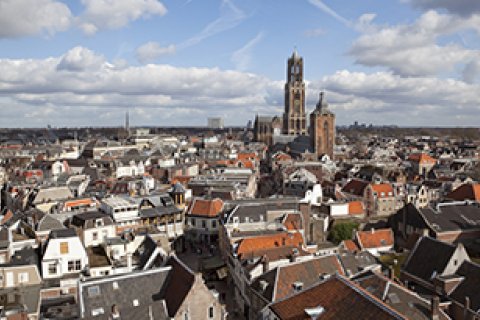Practical information

Venue
The address of the venue:
Zaalverhuur7
Boothstraat 7
3512 BT Utrecht, the Netherlands
(Google Maps)
‘Zaalverhuur7’ is an inspiring location right in the heart of the city, in an authentic church building from 1900 with rooms for small as well as large groups. The rooms have a modern design with just a hint of nostalgia. The homely and warm appearance creates a relaxed atmosphere. By making use of an old church in a sustainable way they want to make a valuable contribution to society. They work with local and global suppliers who have a lot of love for their product. Part of our profit goes to an orphanage in Haiti, among other things.
Zaakverhuur7 works with local and global suppliers who have a lot of love for their product. Organic, fair and sustainable are natural preconditions for them.
How to get to Utrecht
Arrival by train
Utrecht Central Station forms the hub of the Dutch rail network, and is easily accessible directly, or with one change of train, from almost every station in the Netherlands. International trains to the Netherlands are Thalys (Paris), FYRA (Antwerpen/Brussels), ICE International (Germany). For booking and more information check http://www.nshispeed.nl/en
Arrival by plane
The best way to travel from Schiphol Airport to Utrecht is by train. There is a direct train connection between the airport and Utrecht Central Station. It only takes you 30 minutes to travel to Utrecht. The train station is part of Schiphol Plaza, just follow directions for 'trains'.
There is a direct train to Utrecht every 15 minutes. Buy a one way ticket ('enkele reis') to Utrecht Central Station. When in doubt, you can always ask someone at the ticket office. You will soon notice that almost everyone in the Netherlands speaks English fairly well. For journey advice and time tables you can also check: www.ns.nl/en.
Getting around in Utrecht
Utrecht is a medieval city that is easy to navigate by foot. Renting a bike is also an excellent option, this is for instance possible at the Central Station.
Accommodation
The congress organisation has not made any arrangements with hotels in Utrecht. There are several hotels in the city center of Utrecht, from where you can easily walk to the congress venue. These can be found via a hotel booking websites like Booking.com or Hostelworld. Of course, it is also possible to arrange your accommodation peer-to-peer, for instance via Airbnb.
Hotels downtown Utrecht (there are more, but these are close-by)
- Hotel Dom, Domstraat 4
- Hotel NH Centre Utrecht, Janskerkhof 10
- Apollo Hotel Utrecht City, Vredenburg 14
- Stone Hotel & Hostel, Biltstraat 31
- Court Hotel City Centre, Korte Nieuwstraat 14
- Mother Goose Hotel, Ganzemarkt 26
History
Utrecht
Traiectum was the name of a Roman fort, or castellum, on the frontier of the Roman Empire in Germania Inferior. The remains of the fort have been found in the center of Utrecht, Netherlands, which takes its name from the fort. In the Roman Empire Traiectum was one of the forts in the lower Limes Germanicus defensive lines. The Emperor Claudius defined the Rhine downstream from Bonn as the western part of the frontier. He ordered the legions further north to withdraw to this line, which was fortified in AD 47. The Rhine divides into several branches in the Netherlands. The army chose the branch on which modern Utrecht lies as the frontier. http://www.visit-utrecht.com/
Utrecht University
Utrecht University (www.uu.nl) has its origins in the seventh century. Anglo-Saxon monk Willbrord of Utrecht established a school for priests and noblemen in the city. The priests' school was affiliated to the cathedral and later became known as the Dom School. In the 17th century, the City Council founded an Illustere School ('Illustrious School'). In 1636, this officially became Utrecht University, which status gave it the right to confer academic degrees. It was officially opened on 26 March 1636, which remains the Anniversary Day or Dies Natalis to this day.
Copernicus Institute for Sustainable Development
The Copernicus Institute of Sustainable Development is the host of this workshop and is the scientific institute for sustainability research and teaching of Utrecht University. They contribute to the transition to a sustainable society through scientific excellence in a multi-disciplinary environment. There are four research groups: Energy and Resources, Environmental Governance, Environmental Sciences and Innovation Studies. www.uu.nl/copernicus

